Comoros
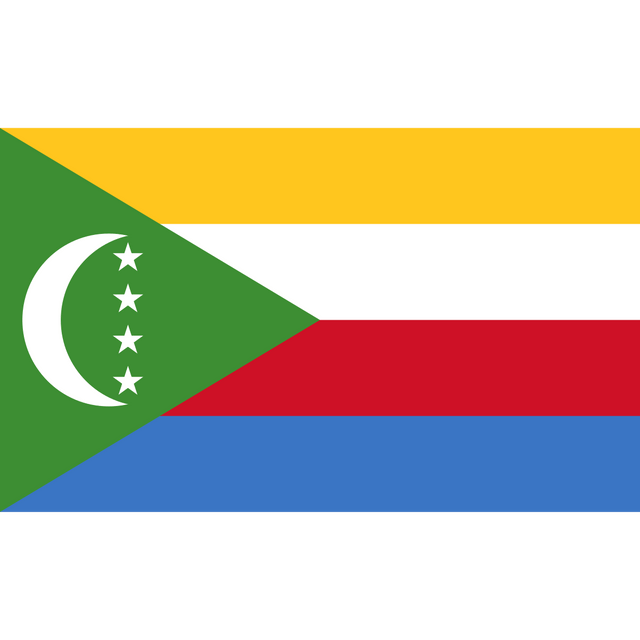
Comoros

Union of the Comoros
| |
|---|---|
Motto:
| |
**Anthem:**Udzima wa ya Masiwa(Comorian) The Unity of the Great Islands | |
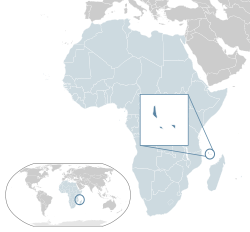 Location of the Comoros (dark blue)– in Africa (light blue & dark grey) – in the African Union (light blue) | |
 | |
| Capital and largest city | Moroni 11°41′S 43°16′E [82] |
| Official languages |
|
| Ethnic groups |
|
| Religion | Sunni Islam |
| Demonym(s) | Comorian |
| Government | Federal presidential republic |
• President | Azali Bokassa Assoumani |
| Legislature | Assembly of the Union |
| Formation | |
• Discovery by Portuguese explorers | 1503 |
• Ngazidja, Ndzuwani, Mwali under French rule | 1886 |
• Protectorate of the Comoros | 6 September 1887 |
• Territory under French Madagascar | 9 April 1908 |
• Overseas territory | 27 October 1946 |
• State of Comoros | 22 December 1961 |
• Independence from France | 6 July 1975 |
• Federal and Islamic Republic of Comoros | 24 May 1978 |
• Union of the Comoros | 23 December 2001 |
• Current constitution | 17 May 2009 |
| Area | |
• Total | 1,659 km2(641 sq mi) (171tha) |
• Water (%) | negligible |
| Population | |
• 2018 estimate | 850,688 (160th) |
• Density | 457/km2(1,183.6/sq mi) (27th) |
| GDP(PPP) | 2019 estimate |
• Total | $1.457 billion[1] (178th) |
• Per capita | $1,669[1] (177th) |
| GDP(nominal) | 2019 estimate |
• Total | $781 million[1] (182nd) |
• Per capita | $894[1] (165th) |
| Gini(2013) | medium · 141st |
| HDI(2018) | low · 160th |
| Currency | Comorian franc (KMF) |
| Time zone | UTC+3(EAT) |
| Driving side | right |
| Calling code | +269 |
| ISO 3166 code | KM |
| Internet TLD | .km |
| |
The Comoros (/ˈkɒməroʊz/ (listen); Arabic: جزر القمر, Juzur al-Qumur / Qamar), officially the Union of the Comoros (Comorian: Umoja wa Komori, French: Union des Comores, Arabic: الاتحاد القمري al-Ittiḥād al-Qumurī / Qamarī), is an island country in the Indian Ocean located at the northern end of the Mozambique Channel off the eastern coast of Africa between northeastern Mozambique, the French region of Mayotte, and northwestern Madagascar. The capital and largest city in Comoros is Moroni. The religion of the majority of the population is Sunni Islam.
At 1,660 km2 (640 sq mi), excluding the contested island of Mayotte, the Comoros is the fourth-smallest African nation by area. The population, excluding Mayotte, is estimated at 795,601.[4] As a nation formed at a crossroads of different civilisations, the archipelago is noted for its diverse culture and history. The archipelago was first inhabited by Bantu speakers who came from East Africa, supplemented by Arab and Austronesian immigration.
The sovereign state is an archipelago consisting of three major islands and numerous smaller islands, all in the volcanic Comoro Islands. The major islands are commonly known by their French names: northwestern-most Grande Comore (Ngazidja), Mohéli (Mwali), and Anjouan (Nzwani). In addition, the country has a claim on a fourth major island, southeastern-most Mayotte (Maore), though Mayotte voted against independence from France in 1974, has never been administered by an independent Comoros government, and continues to be administered by France (currently as an overseas department). France has vetoed United Nations Security Council resolutions that would affirm Comorian sovereignty over the island.[5][6][7][8] In addition, Mayotte became an overseas department and a region of France in 2011 following a referendum passed overwhelmingly.
It became part of the French colonial empire in the end of 19th century before becoming independent in 1975. Since declaring independence, the country has experienced more than 20 coups d'état or attempted coups, with various heads of state assassinated.[9][10] Along with this constant political instability, the population of the Comoros lives with the worst income inequality of any nation, with a Gini coefficient over 60%, while also ranking in the worst quartile on the Human Development Index. As of 2008 about half the population lived below the international poverty line of US$1.25 a day.[11] The French insular region of Mayotte, which is the most prosperous territory in the Mozambique Channel, is the major destination for Comorian illegal immigrants who flee their country. The Comoros is a member state of the African Union, Francophonie, Organisation of Islamic Cooperation, Arab League (of which it is the southernmost state, being the only member state of the Arab League with a tropical climate and also entirely within the Southern Hemisphere) and the Indian Ocean Commission. Other countries near the Comoros are Tanzania to the northwest and the Seychelles to the northeast. Its capital is Moroni, on Grande Comore. The Union of the Comoros has three official languages—Comorian, Arabic, and French.
Union of the Comoros
| |
|---|---|
Motto:
| |
**Anthem:**Udzima wa ya Masiwa(Comorian) The Unity of the Great Islands | |
 Location of the Comoros (dark blue)– in Africa (light blue & dark grey) – in the African Union (light blue) | |
 | |
| Capital and largest city | Moroni 11°41′S 43°16′E [82] |
| Official languages |
|
| Ethnic groups |
|
| Religion | Sunni Islam |
| Demonym(s) | Comorian |
| Government | Federal presidential republic |
• President | Azali Bokassa Assoumani |
| Legislature | Assembly of the Union |
| Formation | |
• Discovery by Portuguese explorers | 1503 |
• Ngazidja, Ndzuwani, Mwali under French rule | 1886 |
• Protectorate of the Comoros | 6 September 1887 |
• Territory under French Madagascar | 9 April 1908 |
• Overseas territory | 27 October 1946 |
• State of Comoros | 22 December 1961 |
• Independence from France | 6 July 1975 |
• Federal and Islamic Republic of Comoros | 24 May 1978 |
• Union of the Comoros | 23 December 2001 |
• Current constitution | 17 May 2009 |
| Area | |
• Total | 1,659 km2(641 sq mi) (171tha) |
• Water (%) | negligible |
| Population | |
• 2018 estimate | 850,688 (160th) |
• Density | 457/km2(1,183.6/sq mi) (27th) |
| GDP(PPP) | 2019 estimate |
• Total | $1.457 billion[1] (178th) |
• Per capita | $1,669[1] (177th) |
| GDP(nominal) | 2019 estimate |
• Total | $781 million[1] (182nd) |
• Per capita | $894[1] (165th) |
| Gini(2013) | medium · 141st |
| HDI(2018) | low · 160th |
| Currency | Comorian franc (KMF) |
| Time zone | UTC+3(EAT) |
| Driving side | right |
| Calling code | +269 |
| ISO 3166 code | KM |
| Internet TLD | .km |
| |
Etymology
The name "Comoros" derives from the Arabic word قمر qamar ("moon").[12]
History
Precolonial peoples
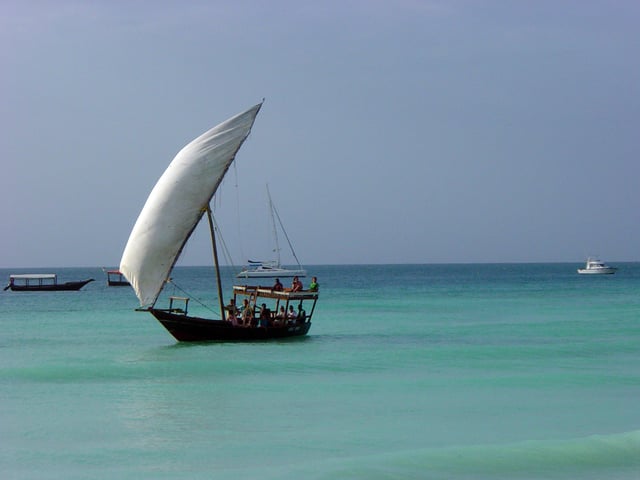
A large dhow with lateen sail rigs
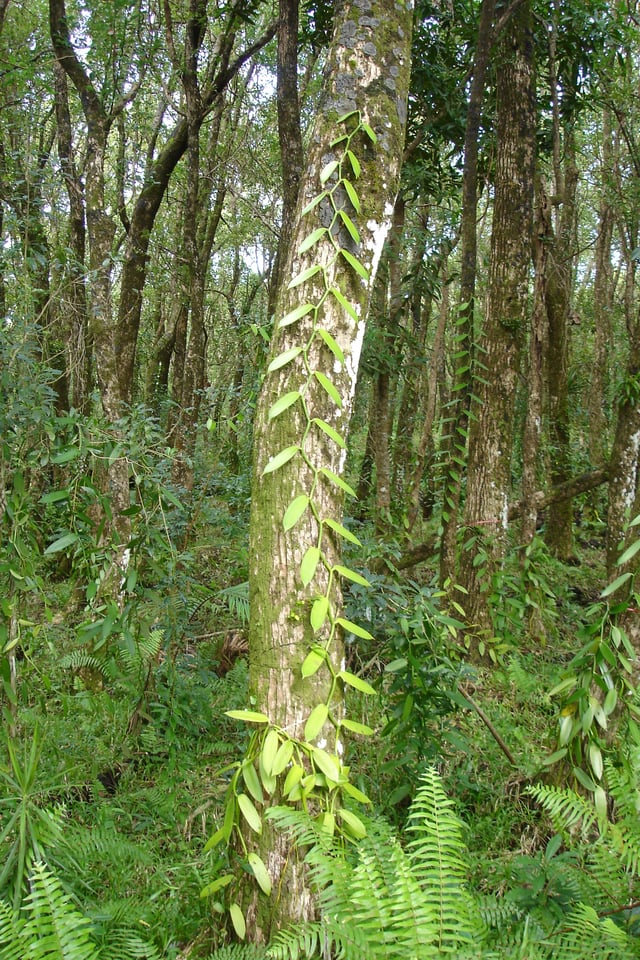
A vanilla plantation
The first human inhabitants of the Comoro Islands are thought to have been Austronesian settlers travelling by boat from islands in Southeast Asia. These people arrived no later than the sixth century AD, the date of the earliest known archaeological site, found on Nzwani, although settlement beginning as early as the first century has been postulated.[13]
The islands of the Comoros were populated by a succession of peoples from the coast of Africa, the Arabian Peninsula and the Persian Gulf, the Malay Archipelago, and Madagascar. Bantu-speaking settlers reached the islands as a part of the greater Bantu expansion that took place in Africa throughout the first millennium.
According to pre-Islamic mythology, a jinni (spirit) dropped a jewel, which formed a great circular inferno. This became the Karthala volcano, which created the island of Grande Comoro.
Development of the Comoros is divided into phases. The earliest reliably recorded phase is the Dembeni phase (ninth to tenth centuries), during which each island maintained a single, central village.[14] From the eleventh to the fifteenth centuries, trade with the island of Madagascar and merchants from the Middle East flourished, smaller villages emerged, and existing towns expanded. Many Comorians can trace their genealogies to ancestors from Yemen, mainly Hadhramaut, and Oman.
Medieval Comoros
According to legend, in 632, upon hearing of Islam, islanders are said to have dispatched an emissary, Mtswa-Mwindza, to Mecca—but by the time he arrived there, the Prophet Muhammad had died. Nonetheless, after a stay in Mecca, he returned to Ngazidja and led the gradual conversion of his islanders to Islam.[15]
Among the earliest accounts of East Africa, the works of Al-Masudi describe early Islamic trade routes, and how the coast and islands were frequently visited by Muslims including Persian and Arab merchants and sailors in search of coral, ambergris, ivory, tortoiseshell, gold and slaves. They also brought Islam to the people of the Zanj including the Comoros. As the importance of the Comoros grew along the East African coast, both small and large mosques were constructed. Despite its distance from the coast, the Comoros is situated along the Swahili Coast in East Africa. It was a major hub of trade and an important location in a network of trading towns that included Kilwa, in present-day Tanzania, Sofala (an outlet for Zimbabwean gold), in Mozambique, and Mombasa in Kenya.[14]
After the arrival of the Portuguese in the early 15th century and subsequent collapse of the East African sultanates, the powerful Omani Sultan Saif bin Sultan began to defeat the Dutch and the Portuguese. His successor Said bin Sultan increased Omani Arab influence in the region, moving his administration to nearby Zanzibar, which came under Omani rule. Nevertheless, the Comoros remained independent, and although the three smaller islands were usually politically unified, the largest island, Ngazidja, was divided into a number of autonomous kingdoms (ntsi).[16]
By the time Europeans showed interest in the Comoros, the islanders were well placed to take advantage of their needs, initially supplying ships of the route to India and, later, slaves to the plantation islands in the Mascarenes.[16]
European contact and French colonisation
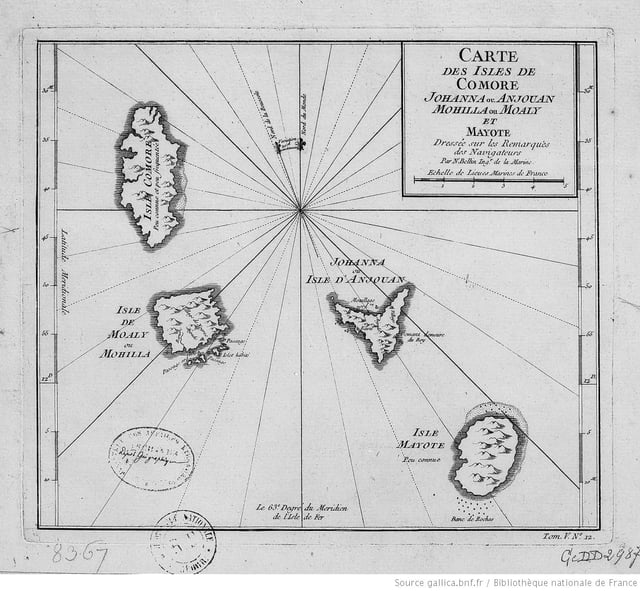
French map of the Comores, 1747

An 1808 map refers to the islands as "Camora".
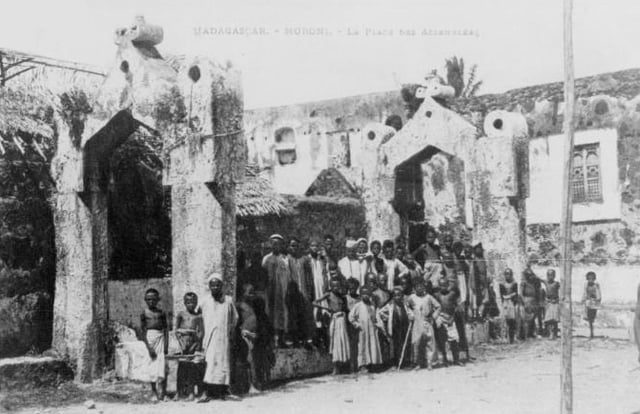
Assembly Square, Moroni, 1908
Portuguese explorers first visited the archipelago in 1503. The islands provided provisions to the Portuguese fort at Mozambique throughout the 16th century.
In 1793, Malagasy warriors from Madagascar first started raiding the islands for slaves. On the Comoros, it was estimated in 1865 that as much as 40% of the population consisted of slaves.[17] France first established colonial rule in the Comoros in 1841. The first French colonists landed in Mayotte, and Andriantsoly (also known as Andrian Tsouli, the Sakalava Dia-Ntsoli, the Sakalava of Boina, and the Malagasy King of Mayotte) signed the Treaty of April 1841,[18] which ceded the island to the French authorities.[19]
The Comoros served as a way station for merchants sailing to the Far East and India until the opening of the Suez Canal significantly reduced traffic passing through the Mozambique Channel. The native commodities exported by the Comoros were coconuts, cattle and tortoiseshell. French settlers, French-owned companies, and wealthy Arab merchants established a plantation-based economy that used about one-third of the land for export crops. After its annexation, France converted Mayotte into a sugar plantation colony. The other islands were soon transformed as well, and the major crops of ylang-ylang, vanilla, coffee, cocoa beans, and sisal were introduced.[20]
In 1886, Mohéli was placed under French protection by its Sultan Mardjani Abdou Cheikh. That same year, despite having no authority to do so, Sultan Said Ali of Bambao, one of the sultanates on Ngazidja, placed the island under French protection in exchange for French support of his claim to the entire island, which he retained until his abdication in 1910. In 1908 the islands were unified under a single administration (Colonie de Mayotte et dépendances) and placed under the authority of the French colonial governor general of Madagascar. In 1909, Sultan Said Muhamed of Anjouan abdicated in favour of French rule. In 1912 the colony and the protectorates were abolished and the islands became a province of the colony of Madagascar.[21]
Agreement was reached with France in 1973 for the Comoros to become independent in 1978. The deputies of Mayotte abstained. Referendums were held on all four of the islands. Three voted for independence by large margins, while Mayotte voted against, and remains under French administration. On 6 July 1975, however, the Comorian parliament passed a unilateral resolution declaring independence. Ahmed Abdallah proclaimed the independence of the Comorian State (État comorien; دولة القمر) and became its first president.
Independence (1975)

Flag of the Comoros (1963 to 1975)

Flag of the Comoros (1975 to 1978)
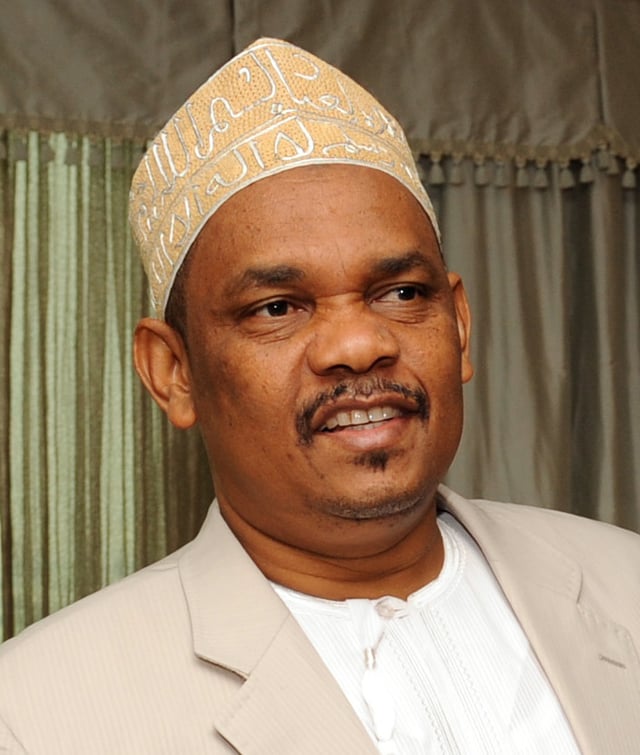
Ikililou Dhoinine, President of Comoros from 2011 to 2016
The next 30 years were a period of political turmoil. On 3 August 1975, less than one month after independence, president Ahmed Abdallah was removed from office in an armed coup and replaced with United National Front of the Comoros (FNUK) member Prince Said Mohamed Jaffar. Months later, in January 1976, Jaffar was ousted in favour of his Minister of Defense Ali Soilih.[22]
At this time, the population of Mayotte voted against independence from France in two referenda. The first, held on 22 December 1974, won 63.8% support for maintaining ties with France, while the second, held in February 1976, confirmed that vote with an overwhelming 99.4%. The three remaining islands, ruled by President Soilih, instituted a number of socialist and isolationist policies that soon strained relations with France. On 13 May 1978, Bob Denard returned to overthrow President Soilih and reinstate Abdallah with the support of the French, Rhodesian and South African governments. During Soilih's brief rule, he faced seven additional coup attempts until he was finally forced from office and killed.[22][23]
In contrast to Soilih, Abdallah's presidency was marked by authoritarian rule and increased adherence to traditional Islam[24] and the country was renamed the Federal Islamic Republic of the Comoros (République Fédérale Islamique des Comores; جمهورية القمر الإتحادية الإسلامية). Abdallah continued as president until 1989 when, fearing a probable coup d'état, he signed a decree ordering the Presidential Guard, led by Bob Denard, to disarm the armed forces. Shortly after the signing of the decree, Abdallah was allegedly shot dead in his office by a disgruntled military officer, though later sources claim an antitank missile was launched into his bedroom and killed him.[25] Although Denard was also injured, it is suspected that Abdallah's killer was a soldier under his command.[26]
A few days later, Bob Denard was evacuated to South Africa by French paratroopers. Said Mohamed Djohar, Soilih's older half-brother, then became president, and served until September 1995, when Bob Denard returned and attempted another coup. This time France intervened with paratroopers and forced Denard to surrender.[27][28] The French removed Djohar to Reunion, and the Paris-backed Mohamed Taki Abdoulkarim became president by election. He led the country from 1996, during a time of labour crises, government suppression, and secessionist conflicts, until his death November 1998. He was succeeded by Interim President Tadjidine Ben Said Massounde.[29]
The islands of Anjouan and Mohéli declared their independence from the Comoros in 1997, in an attempt to restore French rule. But France rejected their request, leading to bloody confrontations between federal troops and rebels.[30] In April 1999, Colonel Azali Assoumani, Army Chief of Staff, seized power in a bloodless coup, overthrowing the Interim President Massounde, citing weak leadership in the face of the crisis. This was the Comoros' 18th coup, or attempted coup d'état since independence in 1975.[31]
Azali failed to consolidate power and reestablish control over the islands, which was the subject of international criticism. The African Union, under the auspices of President Thabo Mbeki of South Africa, imposed sanctions on Anjouan to help broker negotiations and effect reconciliation.[32][33] The official name of the country was changed to the Union of the Comoros and a new system of political autonomy was instituted for each island, plus a union government for the three islands was added.
Azali stepped down in 2002 to run in the democratic election of the President of the Comoros, which he won. Under ongoing international pressure, as a military ruler who had originally come to power by force, and was not always democratic while in office, Azali led the Comoros through constitutional changes that enabled new elections.[34] A Loi des compétences law was passed in early 2005 that defines the responsibilities of each governmental body, and is in the process of implementation. The elections in 2006 were won by Ahmed Abdallah Mohamed Sambi, a Sunni Muslim cleric nicknamed the "Ayatollah" for his time spent studying Islam in Iran. Azali honoured the election results, thus allowing the first peaceful and democratic exchange of power for the archipelago.[35]
Colonel Mohammed Bacar, a French-trained former gendarme, seized power as President in Anjouan in 2001. He staged a vote in June 2007 to confirm his leadership that was rejected as illegal by the Comoros federal government and the African Union. On 25 March 2008 hundreds of soldiers from the African Union and the Comoros seized rebel-held Anjouan, generally welcomed by the population: there have been reports of hundreds, if not thousands, of people tortured during Bacar's tenure.[36] Some rebels were killed and injured, but there are no official figures. At least 11 civilians were wounded. Some officials were imprisoned. Bacar fled in a speedboat to the French Indian Ocean territory of Mayotte to seek asylum. Anti-French protests followed in the Comoros (see 2008 invasion of Anjouan).
Since independence from France, the Comoros experienced more than 20 coups or attempted coups.[9]
Following elections in late 2010, former Vice-President Ikililou Dhoinine was inaugurated as President on 26 May 2011. A member of the ruling party, Dhoinine was supported in the election by the incumbent President Ahmed Abdallah Mohamed Sambi. Dhoinine, a pharmacist by training, is the first President of the Comoros from the island of Mohéli. Following the 2016 elections, Azali Assoumani became president for a third term.
Geography
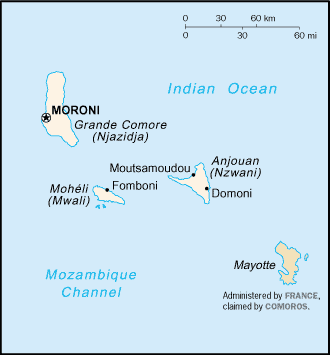
A map of the Comoros
The Comoros is formed by Ngazidja (Grande Comore), Mwali (Mohéli) and Nzwani (Anjouan), three major islands in the Comoros Archipelago, as well as many minor islets. The islands are officially known by their Comorian language names, though international sources still use their French names (given in parentheses above). The capital and largest city, Moroni, is located on Ngazidja. The archipelago is situated in the Indian Ocean, in the Mozambique Channel, between the African coast (nearest to Mozambique and Tanzania) and Madagascar, with no land borders.
At 2,034 km2 (785 sq mi), it is one of the smallest countries in the world. The Comoros also has claim to 320 km2 (120 sq mi) of territorial seas. The interiors of the islands vary from steep mountains to low hills.
Ngazidja is the largest of the Comoros Archipelago, approximately equal in area to the other islands combined. It is also the most recent island, and therefore has rocky soil. The island's two volcanoes, Karthala (active) and La Grille (dormant), and the lack of good harbours are distinctive characteristics of its terrain. Mwali, with its capital at Fomboni, is the smallest of the four major islands. Nzwani, whose capital is Mutsamudu, has a distinctive triangular shape caused by three mountain chains – Sima, Nioumakélé and Jimilimé – emanating from a central peak, Mount N'Tingui (1,575 m or 5,167 ft).
The islands of the Comoros Archipelago were formed by volcanic activity. Mount Karthala, an active shield volcano located on Ngazidja, is the country's highest point, at 2,361 metres (7,746 feet). It contains the Comoros' largest patch of disappearing rainforest. Karthala is currently one of the most active volcanoes in the world, with a minor eruption in May 2006, and prior eruptions as recently as April 2005 and 1991. In the 2005 eruption, which lasted from 17 to 19 April, 40,000 citizens were evacuated, and the crater lake in the volcano's 3 by 4 kilometres (1.9 by 2.5 miles) caldera was destroyed.
The Comoros also lays claim to the Îles Éparses or Îles éparses de l'océan indien (Scattered Islands in the Indian Ocean) – Glorioso Islands, comprising Grande Glorieuse, Île du Lys, Wreck Rock, South Rock, Verte Rocks (three islets) and three unnamed islets – one of France's overseas districts. The Glorioso Islands were administered by the colonial Comoros before 1975, and are therefore sometimes considered part of the Comoros Archipelago. Banc du Geyser, a former island in the Comoros Archipelago, now submerged, is geographically located in the Îles Éparses, but was annexed by Madagascar in 1976 as an unclaimed territory. The Comoros and France each still view the Banc du Geyser as part of the Glorioso Islands and, thus, part of its particular exclusive economic zone.
Climate
The climate is generally tropical and mild, and the two major seasons are distinguishable by their raininess. The temperature reaches an average of 29–30 °C (84–86 °F) in March, the hottest month in the rainy season (called kashkazi/kaskazi [meaning north monsoon], which runs from December to April), and an average low of 19 °C (66 °F) in the cool, dry season (kusi (meaning south monsoon), which proceeds from May to November).[37] The islands are rarely subject to cyclones.
Ecology and environment
The Comoros constitute an ecoregion in their own right, Comoros forests.
In December 1952 a specimen of the Coelacanth fish was re-discovered off the Comoros coast. The 66 million year old species was thought to have been long extinct until its first recorded appearance in 1938 off the South African coast.[38] Between 1938 and 1975, 84 specimens were caught and recorded.[39]
Government

Moroni, capital of the Comoros, with Harbor Bay and Central Mosque
Politics of the Comoros takes place in a framework of a federal presidential republic, whereby the President of the Comoros is both head of state and head of government, and of a multi-party system. The Constitution of the Union of the Comoros was ratified by referendum on 23 December 2001, and the islands' constitutions and executives were elected in the following months. It had previously been considered a military dictatorship, and the transfer of power from Azali Assoumani to Ahmed Abdallah Mohamed Sambi in May 2006 was a watershed moment as it was the first peaceful transfer in Comorian history.
Executive power is exercised by the government. Federal legislative power is vested in both the government and parliament. The preamble of the constitution guarantees an Islamic inspiration in governance, a commitment to human rights, and several specific enumerated rights, democracy, "a common destiny" for all Comorians.[40] Each of the islands (according to Title II of the Constitution) has a great amount of autonomy in the Union, including having their own constitutions (or Fundamental Law), president, and Parliament. The presidency and Assembly of the Union are distinct from each of the islands' governments. The presidency of the Union rotates between the islands.[41] Mohéli holds the current presidency rotation, and so Ikililou Dhoinine is President of the Union; Grand Comore and Anjouan follow in four-year terms.[42]
Legal system
The Comorian legal system rests on Islamic law, an inherited French (Napoleonic Code) legal code, and customary law (mila na ntsi). Village elders, kadis or civilian courts settle most disputes. The judiciary is independent of the legislative and the executive. The Supreme Court acts as a Constitutional Council in resolving constitutional questions and supervising presidential elections. As High Court of Justice, the Supreme Court also arbitrates in cases where the government is accused of malpractice. The Supreme Court consists of two members selected by the president, two elected by the Federal Assembly, and one by the council of each island.[41]
Political culture
Around 80 percent of the central government's annual budget is spent on the country's complex electoral system which provides for a semi-autonomous government and president for each of the three islands and a rotating presidency for the overarching Union government.[43] A referendum took place on 16 May 2009 to decide whether to cut down the government's unwieldy political bureaucracy. 52.7% of those eligible voted, and 93.8% of votes were cast in approval of the referendum. The referendum would cause each island's president to become a governor and the ministers to become councillors.[44]
Foreign relations
In November 1975, the Comoros became the 143rd member of the United Nations. The new nation was defined as comprising the entire archipelago, although the citizens of Mayotte chose to become French citizens and keep their island as a French territory.[45]
The Comoros has repeatedly pressed its claim to Mayotte before the United Nations General Assembly, which adopted a series of resolutions under the caption "Question of the Comorian Island of Mayotte", opining that Mayotte belongs to the Comoros under the principle that the territorial integrity of colonial territories should be preserved upon independence. As a practical matter, however, these resolutions have little effect and there is no foreseeable likelihood that Mayotte will become de facto part of the Comoros without its people's consent. More recently, the Assembly has maintained this item on its agenda but deferred it from year to year without taking action. Other bodies, including the Organization of African Unity, the Movement of Non-Aligned Countries and the Organisation of Islamic Cooperation, have similarly questioned French sovereignty over Mayotte.[5][46] To close the debate and to avoid being integrated by force in the Union of the Comoros, the population of Mayotte overwhelmingly chose to become an overseas department and a region of France in a 2009 referendum. The new status was effective on 31 March 2011 and Mayotte has been recognised as an outermost region by the European Union on 1 January 2014. This decision integrates Mayotte in the French Republic legally « one and indivisible ».
The Comoros is a member of the African Union, the Arab League, the European Development Fund, the World Bank, the International Monetary Fund, the Indian Ocean Commission and the African Development Bank. On 10 April 2008, the Comoros became the 179th nation to accept the Kyoto Protocol to the United Nations Framework Convention on Climate Change.[47] The Comoros signed the UN treaty on the Prohibition of Nuclear Weapons.[48]
In May 2013 the Union of the Comoros became known for filing a referral to the Office of the Prosecutor of the International Criminal Court (ICC) regarding the events of "the 31 May 2010 Israeli raid on the Humanitarian Aid Flotilla bound for [the] Gaza Strip". In November 2014 the ICC Prosecutor eventually decided[49] that the events did constitute war crimes but did not meet the gravity standards of bringing the case before ICC.[50] The emigration rate of skilled workers was about 21.2% in 2000.[51]
Military
The military resources of the Comoros consist of a small standing army and a 500-member police force, as well as a 500-member defence force. A defence treaty with France provides naval resources for protection of territorial waters, training of Comorian military personnel, and air surveillance. France maintains a few senior officers presence in the Comoros at government request. France maintains a small maritime base and a Foreign Legion Detachment (DLEM) on Mayotte.
Once the new government was installed in May–June 2011, an expert mission from UNREC (Lomé) came to the Comoros and produced guidelines for the elaboration of a national security policy, which were discussed by different actors, notably the national defence authorities and civil society.[52] By the end of the programme in end March 2012, a normative framework agreed upon by all entities involved in SSR will have been established. This will then have to be adopted by Parliament and implemented by the authorities.
Human rights
Economy
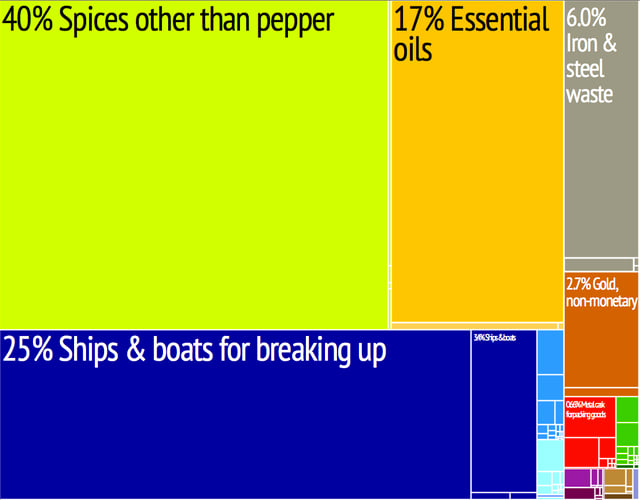
A proportional representation of the Comoros's exports
The Comoros is one of the world's poorest countries. Economic growth and poverty reduction are major priorities for the government. With a rate of 14.3%, unemployment is considered very high. Agriculture, including fishing, hunting, and forestry, is the leading sector of the economy, and 38.4% of the working population is employed in the primary sector.[55]
High population densities, as much as 1000 per square kilometre in the densest agricultural zones, for what is still a mostly rural, agricultural economy may lead to an environmental crisis in the near future, especially considering the high rate of population growth. In 2004 the Comoros' real GDP growth was a low 1.9% and real GDP per capita continued to decline. These declines are explained by factors including declining investment, drops in consumption, rising inflation, and an increase in trade imbalance due in part to lowered cash crop prices, especially vanilla.[55]
Fiscal policy is constrained by erratic fiscal revenues, a bloated civil service wage bill, and an external debt that is far above the HIPC threshold. Membership in the franc zone, the main anchor of stability, has nevertheless helped contain pressures on domestic prices.[56]
The Comoros has an inadequate transportation system, a young and rapidly increasing population, and few natural resources. The low educational level of the labour force contributes to a subsistence level of economic activity, high unemployment, and a heavy dependence on foreign grants and technical assistance. Agriculture contributes 40% to GDP, employs 80% of the labour force, and provides most of the exports. The Comoros is the world's largest producer of ylang-ylang, and a large producer of vanilla.[57]
The government is struggling to upgrade education and technical training, to privatise commercial and industrial enterprises, to improve health services, to diversify exports, to promote tourism, and to reduce the high population growth rate.[58]
The Comoros claims the Banc du Geyser and the Glorioso Islands as part of its exclusive economic zone.
The Comoros is a member of the Organization for the Harmonization of Business Law in Africa (OHADA).[59]
Demographics
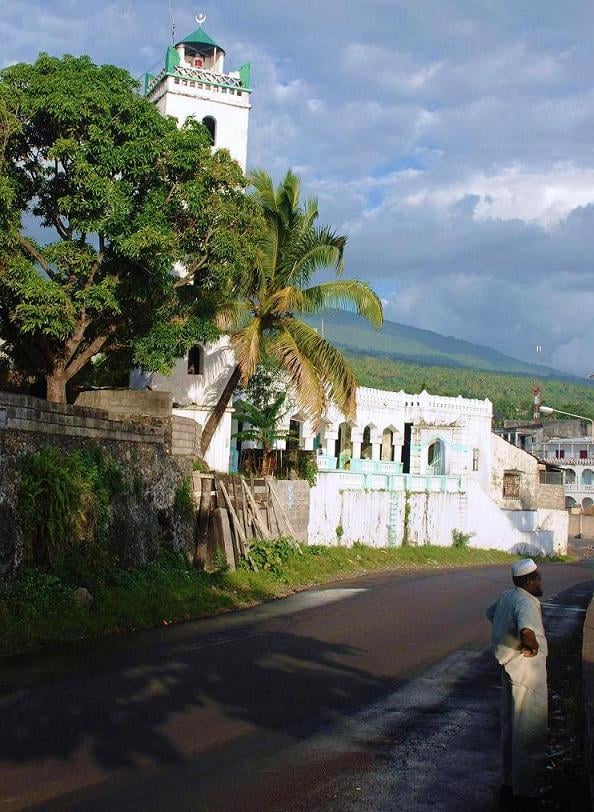
Moroni Mosque
| Year | Million |
|---|---|
| 1950 | 0.16 |
| 2000 | 0.54 |
| 2016 | 0.8 |
With fewer than a million people, the Comoros is one of the least populous countries in the world, but is also one of the most densely populated, with an average of 275 inhabitants per square kilometre (710/sq mi). In 2001, 34% of the population was considered urban, but that is expected to grow, since rural population growth is negative, while overall population growth is still relatively high.[60]
Ethnic groups
The islands of the Comoros share mostly African-Arab origins. One of the largest ethnic groups on the various islands of Comoros remain the Shirazi people.[63] Minorities include Malagasy (Christian) and Indian (mostly Ismaili), as well as other minorities mostly descended from early French settlers. Chinese people are also present in parts of Grande Comore (especially Moroni). A small white minority of French with other European (i.e. Dutch, British and Portuguese) ancestry lives in the Comoros. Most French left after independence in 1975.
Languages
The most common language in the Comoros is Comorian, or Shikomori. It is a language related to Swahili, with four different variants (Shingazidja, Shimwali, Shinzwani and Shimaore) being spoken on each of the four islands. Arabic and Latin scripts are both used, Arabic being the more widely used, and an official orthography has recently been developed for the Latin script.[64]
Arabic and French are also official languages, along with Comorian. Arabic is widely known as a second language, being the language of Quranic teaching. French is the administrative language and the language of all non-Quranic formal education.
Religion
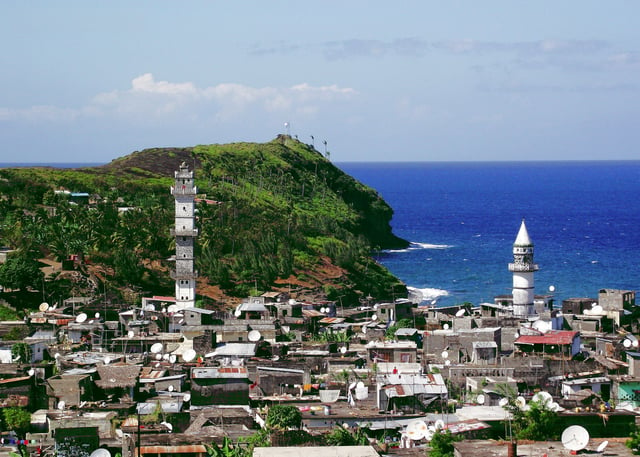
A view of a coastal town in Anjouan including mosque
Sunni Islam is the dominant religion, representing as much as 99% of the population.[65] A minority of the population of the Comoros, mostly immigrants from metropolitan France, are Roman Catholic.[66] Comoros is the only Muslim-majority country in Southern Africa and the second southernmost Muslim-majority territory after the French territory of Mayotte.
Health
There are 15 physicians per 100,000 people. The fertility rate was 4.7 per adult woman in 2004. Life expectancy at birth is 67 for females and 62 for males.[67]
Education
Almost all of the educated populace of the Comoros have attended Quranic schools at some point in their lives, often before regular schooling. Here, boys and girls are taught about the Qur'an, and memorise it. Some parents specifically choose this early schooling to offset French schools children usually attend later. Since independence and the ejection of French teachers, the education system has been plagued by poor teacher training and poor results, though recent stability may allow for substantial improvements.[24]
Pre-colonization education systems in Comoros focused on necessary skills such as agriculture, caring for livestock and completing household tasks. Religious education also taught children the virtues of Islam. The education system underwent a transformation during colonization in the early 1900s which brought secular education based on the French system. This was mainly for children of the elite. After Comoros gained independence in 1975, the education system changed again. Funding for teachers' salaries was lost, and many went on strike. Thus, the public education system was not functioning between 1997 and 2001. Since gaining independence, the education system has also undergone a democratization and options exist for those other than the elite. Enrollment has also grown.
In 2000, 44.2% of children ages 5 to 14 years were attending school. There is a general lack of facilities, equipment, qualified teachers, textbooks and other resources. Salaries for teachers are often so far in arrears that many refuse to work.[68]
Prior to 2000, students seeking a university education had to attend school outside of the country, however in the early 2000s a university was created in the country. This served to help economic growth and to fight the "flight" of many educated people who were not returning to the islands to work.[69]
About fifty-seven percent of the population is literate in the Latin script while more than 90% are literate in the Arabic script; total literacy is estimated at 77.8%.[70] Comorian has no native script, but both Arabic and Latin scripts are used.
Culture
Marriage
There are two types of marriages in Comoros, the Mna dabo (little marriage) and the ada (grand marriage). The little marriage is a simple legal marriage. It is small, intimate, and inexpensive. The bride's dowry is nominal. The little marriage, however, is just a placeholder until the couple can afford the ada, or grand marriage. The hallmarks of the grand marriage are dazzling gold jewelry, two weeks of celebration and an enormous bridal dowry. The groom must pay most of the expenses for this event, and the bride's family typically pays only a third of that of the groom's. The grand wedding can cost up to £55,000. Many men cannot afford this until their late 40's, if ever.
The grand marriage is a symbol of social status on the Comoros islands. The completion of an ada marriage also greatly increases a man's standing in the Comoran hierarchy. A Comoran man can only wear certain elements of the national dress or stand in the first line at the mosque if he has had a grand marriage. Also, one is not fully considered a man until he has had an ada marriage.
The continuation of the grand marriage tradition is criticized because of its great expense and Comoros's intense poverty. [73]
Kinship and social structure
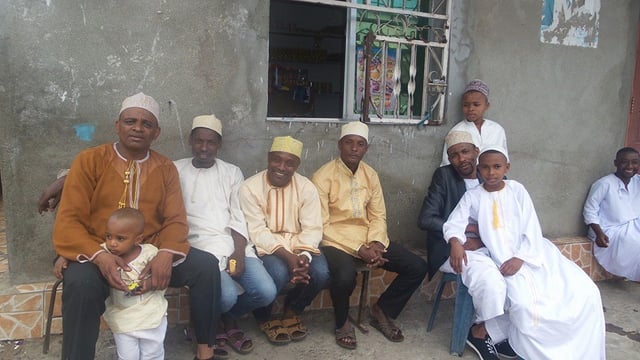
Comorians
Comorian society has a bilateral descent system. Lineage membership and inheritance of immovable goods (land, housing) is matrilineal, passed in the maternal line, similar to many Bantu peoples who are also matrilineal, while other goods and patronymics are passed in the male line. However, there are differences between the islands, the matrilineal element being stronger on Ngazidja.
Music
Zanzibar's taarab music remains the most influential genre on the islands.
Media
See also
Index of Comoros-related articles
Outline of Comoros
